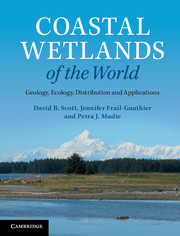Book contents
- Frontmatter
- Contents
- Preface
- List of acronyms and abbreviations
- 1 Introduction: what is covered in this coastal wetlands book?
- 2 Physical aspects: geological, oceanic and climatic conditions
- 3 Zonations and plants: development, stressors and adaptations
- 4 Animals in coastal wetlands: zonation, adaptations and energy flow
- 5 Human intervention causing coastal problems
- 6 Coastal wetlands worldwide: climatic zonation, ecosystems and biogeography
- 7 Examples of North American salt marshes and coastal wetlands
- 8 Examples of South American coastal wetlands
- 9 Africa: selected marsh and mangrove areas
- 10 Europe and Asia: a view of what remains
- 11 Australasia: wetlands of Australia and New Zealand
- 12 Applications in geological monitoring: paleoseismology and paleoclimatology
- 13 Applications in conservation of plant biodiversity and agriculture
- 14 Using mesocosms as a way to study coastal wetlands
- 15 Conclusions and future directions
- References
- Index
- Plate section
9 - Africa: selected marsh and mangrove areas
Published online by Cambridge University Press: 05 July 2014
- Frontmatter
- Contents
- Preface
- List of acronyms and abbreviations
- 1 Introduction: what is covered in this coastal wetlands book?
- 2 Physical aspects: geological, oceanic and climatic conditions
- 3 Zonations and plants: development, stressors and adaptations
- 4 Animals in coastal wetlands: zonation, adaptations and energy flow
- 5 Human intervention causing coastal problems
- 6 Coastal wetlands worldwide: climatic zonation, ecosystems and biogeography
- 7 Examples of North American salt marshes and coastal wetlands
- 8 Examples of South American coastal wetlands
- 9 Africa: selected marsh and mangrove areas
- 10 Europe and Asia: a view of what remains
- 11 Australasia: wetlands of Australia and New Zealand
- 12 Applications in geological monitoring: paleoseismology and paleoclimatology
- 13 Applications in conservation of plant biodiversity and agriculture
- 14 Using mesocosms as a way to study coastal wetlands
- 15 Conclusions and future directions
- References
- Index
- Plate section
Summary
Key points
Africa’s pantropical location bridges Atlantic and Indian Ocean mangrove forests; microtides support extensive estuarine and lagoonal wetlands on low coastal plains; population growth drives wetlands degradation and escalates mangrove loss from global warming and sea level rise; now many African countries are conserving and restoring mangroves; the case history for the Gambia River, Africa’s longest estuary, illustrates problems of protecting mangroves for services to local peoples; the Nile Delta on the world’s longest river records near-disappearance of the wetlands over the past ~2000 years; in South Africa, a 220 km-long UNESCO World Heritage Site spanning St. Lucia Bay (iSisangaliso) marks growing awareness of estuarine values and conservation needs; smaller East African sites have escaped major changes and new studies show caution is needed when interpreting wetland changes from grey mangrove pollen archives.
Location and biodiversity: introduction to Africa as a pantropical bridge
The continent of Africa effectively is a link between the New World continents of North and South America (Chapters 7–8) and the Old World regions of Europe and Asia (Chapter 10), with its southern satellites, Australia and New Zealand (Chapter 11). The African continent spans the Equator roughly equally north and south (36° N to ~35° S), covering warm- temperate and tropical regions, but not extending into any cool climate or polar region (Figure 9.1). Most of Africa lies in the Afrotropical biodiversity region of the Ramsar Convention (1977). However, the West Coast wetlands border the Atlantic–East Pacific biogeographical region, while the East Coast wetlands border the Indian Ocean and belong to the Indo-West Pacific region. Hence, Africa, the least industrially developed continent in the world, is a transition zone between the long-settled Old World and the rapidly settled and exploited New World.
- Type
- Chapter
- Information
- Coastal Wetlands of the WorldGeology, Ecology, Distribution and Applications, pp. 153 - 185Publisher: Cambridge University PressPrint publication year: 2014



